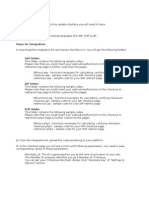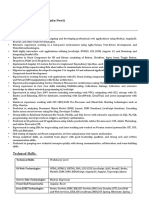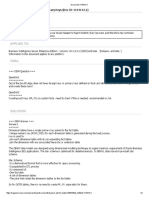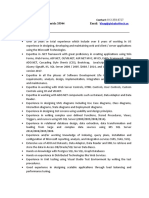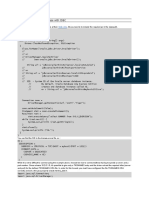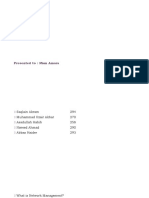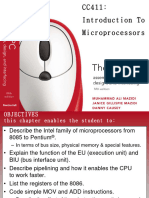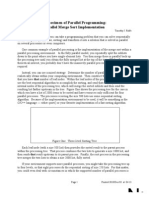Programming and Erasing Flash Memory by User Program For Traveo ™ Family
Programming and Erasing Flash Memory by User Program For Traveo ™ Family
Uploaded by
Night ShadeCopyright:
Available Formats
Programming and Erasing Flash Memory by User Program For Traveo ™ Family
Programming and Erasing Flash Memory by User Program For Traveo ™ Family
Uploaded by
Night ShadeOriginal Title
Copyright
Available Formats
Share this document
Did you find this document useful?
Is this content inappropriate?
Copyright:
Available Formats
Programming and Erasing Flash Memory by User Program For Traveo ™ Family
Programming and Erasing Flash Memory by User Program For Traveo ™ Family
Uploaded by
Night ShadeCopyright:
Available Formats
AN212061
Programming and Erasing Flash Memory by User Program for Traveo™ Family
Author: Hirofumi Arakawa
Associated Part Family: S6J3110/S6J3120/S6J3200/S6J3300/S6J3350/S6J3360/S6J3370/
S6J3400 Series
Related Documents: For a complete list, click here.
This application note describes how to program and erase the flash memory by user program for the Traveo family.
Major topics include the operation explanation of TCFLASH, the explanation of TCFLASH command and the
explanation of an example of TCFLASH reprogramming.
Contents
1 Introduction ..................................................................1 4.3 Program Command Sequence (64-bit) ............... 9
2 Overview of Flash Memory ..........................................1 4.4 Macro Erase (Chip Erase) Command Sequence
2.1 TCFLASH memory..............................................2 ............................................................................ 9
2.2 WorkFlash Memory .............................................3 4.5 Sector Erase Command Sequence .................. 10
3 TCFLASH Operation ...................................................3 5 TCFLASH Reprogramming Procedure ...................... 10
3.1 TCFLASH Operation Mode .................................3 5.1 Enable Programming ........................................ 12
3.2 Programming and Erasing TCFLASH .................3 5.2 Sector Erase Sequence .................................... 13
3.3 Command Sequence for S6J3110/S6J3120/ 5.3 Program Sequence ........................................... 14
S6J3200 ..............................................................3 6 Related Documents ................................................... 15
3.4 Command Sequence for S6J3300/S6J3350/ Document History............................................................ 16
S6J3360/S6J3370/S6J3400................................5 Worldwide Sales and Design Support ............................. 17
3.5 Automatic Algorithm Execution Status ................8 Products .......................................................................... 17
4 Command ....................................................................9 PSoC® Solutions ............................................................ 17
4.1 Reset and Read Command.................................9 Cypress Developer Community....................................... 17
4.2 Program Command Sequence............................9 Technical Support ........................................................... 17
1 Introduction
This application note describes how to program and erase the flash memory of the Traveo family. In this document,
Traveo family refers to S6J3110/S6J3120/S6J3200/S6J3300/S6J3350/S6J3360/S6J3370/S6J3400 series.
2 Overview of Flash Memory
The Traveo family includes two types of flash memories: TCM flash (TCFLASH) and work flash (WorkFlash).
TCFLASH is a flash memory to mainly store programs for Traveo family. WorkFLASH is rewritable, non-volatile data
memory for Traveo Family. Please refer to the TRM (Technical Reference Manual) of Traveo family for details of
TCFLASH and WorkFlash.
www.cypress.com Document No. 002-12061 Rev. *B 1
Programming and Erasing Flash Memory by User Program for Traveo™ Family
2.1 TCFLASH memory
TCFLASH is a flash memory that is used mainly to store programs. If the Traveo microcontroller is in user mode, it
will be mapped to two regions: the TCM and the AXI region. TCM is the abbreviation of the Tightly Coupled Memory,
it is memory that can be accessed at high speed and is directly coupled to the processor core. TCM is one of the
ARM architecture. AXI is the abbreviation of the Advanced eXtensible Interface, and AXI is the most widespread
AMBA interface. Please refer to a document of ARM® architecture for details of TCM and AXI. If the TCFLASH is
accessed via the TCM region, it will be treated as an L1 memory on the ARM® architecture. Therefore, non-
cacheable and low-latency access is possible. However, if it is accessed via the AXI region, it is treated as an L2
memory in the context of the ARM architecture.
Programming or erasing of TCFLASH can be performed, if it is accessed via the AXI region by sending a program
sequence. However, programming or erasing cannot be performed when it is accessed via the TCM region.
Programming with access via the AXI region has the highest priority in TCFLASH. With the default setting,
reading priority is toggled between accesses via the AXI region and accesses via the TCM region every 16 clock
cycle.
In TCFLASH, set the priority to allow reading with access via the TCM region. However, reading has a lower
priority than programming.
It is possible to read 8-bit/16-bit/32-bit/64-bit data from CPU.
ECC (Error Check and Correct) is supported only in AXI with the same calculation formula as that for the ARM
Cortex-R5F core, with 1-bit error correction and 2-bit error detection. If ECC is enabled, programming from the CPU
is possible only in 16- or 32-bit mode. If ECC is disabled, programming from the CPU is possible in 8-, 16-, or 32-bit
mode.
A TCFLASH memory is available only for the CPU core and is placed on the memory map by the program, as shown
in Figure 1.
Figure 1. Position of TCFLASH on Memory Map
Address
0x06000000
TCFLASH AXI region
0x05000000
TCM region
0x04800000
(TCRAM region)
0x04000000
0x02000000
AXI region
0x01000000
TCM region
0x00800000
(TCRAM region)
0x00000000
www.cypress.com Document No. 002-12061 Rev.*B 2
Programming and Erasing Flash Memory by User Program for Traveo™ Family
A block diagram of the TCFLASH is shown in Figure 2.
Figure 2. Block Diagram for TCFLASH and Cortex-R5F
TCM Interface
Cortex-R5F
TCFLASH
Core
AXI AXI
HPM (High-Performance Matrix)
2.2 WorkFlash Memory
The WorkFlash memory does the following:
Enables reading in units of 8, 16, 32, or 64 bits.
Provides an ECC function, with 1-bit error correction and 2-bit error detection.
Enables switching between the enabled and disabled states of the ECC function through a register setting.
Enables switching between ECC-enabled access and ECC-disabled access using two mirror areas.
Writes the data and the ECC generated from the 64 bits.
3 TCFLASH Operation
3.1 TCFLASH Operation Mode
Traveo family when in user mode, the CPU or other bus masters can access the TCFLASH. A Cortex-R5F core can
access the TCFLASH that is connected to itself via the TCM or AXI interface.
3.2 Programming and Erasing TCFLASH
Traveo family when in user mode, programming/erasing of TCFLASH is done by writing the programming access
sequence in the flash memory via the AXI region.
Programming and erasing can be performed by sending the program access sequence to flash memory to start an
automatic algorithm. The available commands in the automatic algorithm include reset, read, program, macro erase,
and sector erase. For the sector erase command, it is possible to control the suspension and resumption of its
execution.
3.3 Command Sequence for S6J3110/S6J3120/S6J3200
To start an automatic algorithm, program the given data to a given address one to seven times consecutively,
depending on the command type.
Specify the values shown in Table 1 for CA1 and in Table 2 for CA0.
Specify the value of the lower 32 bits of the 64-bit program data for PD64_0 in Table 1. Specify the value of the
upper 32 bits of the 64-bit program data for PD64_1.
Except for the program data that is represented as PD, PD64_0, PD64_1 in Table 1, the upper 24 bits (bit 31 to
bit 8) of data to be programmed to start an automatic algorithm are ignored.
In Table 2, ***** is an arbitrary value that specifies the address range used by the flash memory for which the
command is executed. For the memory map, see Figure 1.
The address, PA, given in the 4th write cycle is the address in to which the program data, PD, is written.
The programming address, PA, for programming must be a value that is aligned to the programming-size.
www.cypress.com Document No. 002-12061 Rev.*B 3
Programming and Erasing Flash Memory by User Program for Traveo™ Family
The address SA given in the 6th program cycle of the sector erase command indicates the address of the sector
to be erased. SA is specified in the same format as PA.
The flash memory is reset and transitions to read mode if an invalid address or data set is programmed as a
command or if commands are programmed in the wrong order.
The read operation from flash memory is possible even when the command sequence is being programmed. The
automatic algorithm starts upon completion of the last cycle of the program sequence.
Do not specify the sector address for which sector protection is enabled for CA0, CA1, SA, SA0, SA1, and PA.
Do not change the setting of the sector protection register for TCFLASH (TCFCFG0_C*SWP) while writing the
command sequence.
Flash memory must not be read-accessed until the status register READ changes to “1” after the sector erase
suspend command is issued.
www.cypress.com Document No. 002-12061 Rev.*B 4
Programming and Erasing Flash Memory by User Program for Traveo™ Family
Table 1. Command Sequence List
1st Cycle 2nd Cycle 3rd Cycle 4th Cycle 5th Cycle 6th Cycle 7th Cycle
Command
Address Data Address Data Address Data Address Data Address Data Address Data Address Data
Reset CA0 0xF0 – – – – – – – – – – – –
Read RA RD – – – – – – – – – – – –
Program CA0 0xAA CA1 0x55 CA0 0xA0 PA PD – – – – – –
Program
CA0 0xAA CA1 0x55 CA0 0xAC PA PD64_0 any PD64_1 – – – –
(64 bit)
Macro Erase
CA0 0xAA CA1 0x55 CA0 0x80 CA0 0xAA CA1 0x55 CA0 0x10 – –
(Chip Erase)
Sector Erase CA0 0xAA CA1 0x55 CA0 0x80 CA0 0xAA CA1 0x55 SA0 0x30 – –
Multiple
CA0 0xAA CA1 0x55 CA0 0x80 CA0 0xAA CA1 0x55 SA0 0xE0 SA1 0x30
Sectors Erase
Sector Erase
SA 0xB0 – – – – – – – – – – – –
Suspend
Sector Erase
SA 0x30 – – – – – – – – – – – –
Resume
CAx: Refer to Table 2. RA: Read Address, RD: Read Data, SAx: Sector Address, PA: Program Address, PD: Program Data, PD64_0: Program Data (lower
32 bits of 64-bit program data), PD64_1: Program Data (upper 32 bits of 64-bit program data).
Table 2. Address in the Command
Operation Mode Code (Table 1) Offset in AXI region
CA0 0x*****AA8
User mode
CA1 0x*****554
3.4 Command Sequence for S6J3300/S6J3350/S6J3360/S6J3370/S6J3400
To start an automatic algorithm, preambles of the command sequence are first sent to the flash memory before
sending the data. The preambles determine the modes of the flash programming/erasing. Depending on the modes,
the number of the cycles for the preambles as well as for the data varies. Detailed information of different modes is
given in Table 4. In the following, explanations are given to Table 4.
The address PA given at the 4th write cycle is the address in which program data PD is written. The commands
before the sending of PA and PD are preamble commands. The preambles have explicit addresses and data
values.
For addresses containing the "any" entry, it means that basically any valid Flash address can be used. However,
it must be ensured, that the Flash address used has not a disabled sector write permission
(TCFCFG0_CSWPx[n]=0). Otherwise the command is dropped and an error response is returned.
For the 256bit programming mode, the "nth cycle" is 7th to 11th cycle.
For the page mode, the "kth cycle" is 12th to 131st cycle.
In Table 5, ***** is an arbitrary value that specifies the address range used by the flash memory for which the
command is executed. The write permission of the given address must be set to "enabled". Therefore, it is
recommended that the resulting Flash address should fall into the target sector. For the memory map, see
Figure 1.
To allow the macro erase operation, all sector write permissions must be set to "enabled".
www.cypress.com Document No. 002-12061 Rev.*B 5
Programming and Erasing Flash Memory by User Program for Traveo™ Family
For the 16bit/32bit programming mode, the size of input data determines whether the programming is 16bit or
32bit mode.
For the 16bit mode, the bit1 of the address determines which half of the 32bit-word in the flash is programmed. If
bit1 is "0", the lower 16 bits of the 32-word are programmed. If bit1 is "1", the higher 16 bits are programmed.
For the 64bit/256bit/page programming mode, the PDs are written to the flash memory at addresses in an
increasing sequence.
For the 64bit/256bit/page programming mode, only the address of the first 32bit-word at cycle 4 is accepted by
the flash memory. The addresses starting from cycle 5 are ignored by the flash memory.
8-bit programming mode does not exist.
The allowed data types for the user to program the flash must be of 16 bits or 32 bits. This rule applies not only
to the programming data, but also to the preambles.
Programming the flash using burst mode is prohibited.
The programming address PA for programming must be a value which is programming size aligned.
The address SA given upon the 6th program cycle of the sector erase command indicates the address of the
sector to be erased. SA is specified in the same format as PA.
Flash memory is reset and transitions to read mode if an invalid address or data set is programmed as a
command or if commands are programmed in the wrong order.
The read operation from flash memory is possible even when the command sequence is being programmed. The
automatic algorithm starts upon completion of the last cycle of the program sequence.
Do not change the setting of the sector write permission register for TCFLASH (TCFCFG0_CSWP*) while writing
the command sequence.
Two modes of sector erase suspend exist described in the following table.
Table 3. Two Modes of Sector Erase Suspend
Maximum time from
Minimum time from
Command suspend command to Erase progress
resume till next suspend
suspend state
Sector Erase Suspend 1 Short Long Guaranteed by user
Sector Erase Suspend 2 Long Short Guaranteed by flash
Flash memory must not be read-accessed until the status register READ changes to "1" after the sector erase
suspend command is issued.
The embedded algorithm operation reset command is one type of hardware reset, which terminates the
Automatic Algorithm state (Program/Macro Erase/Sector Erase) of flash and changes to Normal Command state.
In the Normal Command state, this macro accepts automatic algorithm execution commands (write) for executing
program/erase operations and read commands (read).
The "Command Reset" command resets the execution commands before the flash enters the Automatic
Algorithm state, and enables re-write the command from the beginning.
www.cypress.com Document No. 002-12061 Rev.*B 6
Programming and Erasing Flash Memory by User Program for Traveo™ Family
Table 4. Command Sequence List for S6J3300/S6J3350/S6J3360/S6J3370/S6J3400
1st Cycle 2nd Cycle 3rd Cycle 4th Cycle 5th Cycle 6th Cycle nth Cycle kth Cycle
Command
Address Data Address Data Address Data Address Data Address Data Address Data Address Data Address Data
Program
CA0 0xAA CA1 0x55 CA0 0xA0 PA PD – – – – – – – –
(16bit/32bit)
Program
CA0 0xAA CA1 0x55 CA0 0xAC PA PD any PD – – – – – –
(64 bit)
Program
CA0 0xAA CA1 0x55 CA0 0xA4 PA PD any PD any PD any PD – –
(256 bit)
Page
CA0 0xAA CA1 0x55 CA0 0xA8 PA PD any PD any PD any PD any PD
Program
Macro Erase
CA0 0xAA CA1 0x55 CA0 0x80 CA0 0xAA CA1 0x55 CA0 0x10 – – – –
(Chip Erase)
Sector
CA0 0xAA CA1 0x55 CA0 0x80 CA0 0xAA CA1 0x55 SA 0x30 – – – –
Erase
Multiple
Sector CA0 0xAA CA1 0x55 CA0 0x80 CA0 0xAA CA1 0x55 SA 0xE0 SA 0xE0 SA 0x30
Erase
Sector
Erase any 0xB0 – – – – – – – – – – – – – –
suspend 1
Sector
Erase any 0xBC – – – – – – – – – – – – – –
suspend 2
Erase
any 0x30 – – – – – – – – – – – – – –
resume
Embedded
Algorithm
any 0xF4 – – – – – – – – – – – – – –
Operation
Reset
Command
any 0xF0 – – – – – – – – – – – – – –
Reset
CAx: Refer to Table 5. RA: Read Address, RD: Read Data, SAx: Sector Address, PA: Program Address, PD: Program Data
Table 5. Address in the Command
Operation Mode Code (Table 4) Offset in AXI region
CA0 0x*****AA8
User mode
CA1 0x*****554
www.cypress.com Document No. 002-12061 Rev.*B 7
Programming and Erasing Flash Memory by User Program for Traveo™ Family
3.5 Automatic Algorithm Execution Status
The detailed status of the flash memory during the execution of an automatic algorithm can be confirmed by reading
the TCFCFG_FSTAT: TCFLASH status register to check the value of each bit (refer to Table 6.) Use this status
register when you use the TCFLASH. It consists of the following bits: CERS, PGMS, ESPS, ERSEC, SERS, READ,
HANG, and RDY. Each bit indicates the status listed in Table 7.
If the flash memory is read during the execution of the automatic algorithm, a bus error response occurs.
Table 6. Bit Assignment of TCFLASH Status Register
Bit No. 7 6 5 4 3 2 1 0
Flag name CERS PGMS ESPS ERSEC SERS READ HANG RDY
Table 7. Values of TCFLASH Status Register
State CERS PGMS ESPS ERSEC SERS READ HANG RDY
Reset 0 0 0 0 0 0 0 0
Command 0 0 0 0 0 1 0 1
Program 0 1 0 0 0 0 0 0
Macro erase 1 0 0 0 0 0 0 0
Sector erase 0 0 0 0 1 0 0 0
Sector read
0 0 1 1 1 1 0 1
Interruption of during erasure
sector Not-target
erasure sector read 0 0 1 0 1 1 0 1
during erasure
Program 0 1 0 0 0 0 1 0
Hang-up 1 Macro erase 1 0 0 0 0 0 1 0
Sector erase 0 0 0 0 1 0 1 0
PGMS (Program Status) bit: This bit indicates the programming status.
CERS (Chip Erase Status) bit: This bit indicates the macro erase status. Any command can be received until
macro erase is completed.
SERS (Sector Erase Status) bit: This bit indicates the sector erase status. During sector erase, sector erase
suspend commands can be received.
ESPS (Erase Suspend Status) bit: This bit indicates the sector erase suspend status. Reading and
programming can be done for sectors other than erase targets. They cannot be done for sectors that are erase
targets. The sector erase resume command resumes sector erase.
ERSEC (Erase Suspend Sector status) bit: This bit indicates the status in which a target sector read is being
executed while sector erase is suspended. At this time, the data read from flash memory is not the correct data.
READ (Read) bit: This bit indicates the readable status of the TCFLASH.
HANG (Hang-up 1 status) bit: This bit indicates the Hang-up 1 status, which indicates that one of the following
events occurred:
An attempt has occurred to overwrite with value “1” an address to which the value of “0” has been written.
Programming, macro erase, and sector erase are not completed within the time limit.
In the Hang-up 1 status, the status of the TCFLASH can be recovered by writing a command reset.
www.cypress.com Document No. 002-12061 Rev.*B 8
Programming and Erasing Flash Memory by User Program for Traveo™ Family
RDY (Ready) bit: This bit indicates the programmable/erasable status of the TCFLASH or WorkFlash memory.
When the WorkFlash memory is programmable/erasable, this bit becomes “0”.
The TCFLASH status can be confirmed with the READ and RDY bits.
READ=0, RDY=0: Reset (TCFLASH: Waiting for ready)
READ=0, RDY=1: Reading TCFLASH (TCFLASH: Waiting for ready)
READ=1, RDY=1: NOP (TCFLASH: Readable/programmable/erasable)
READ=1, RDY=0: WorkFlash memory programming/erasing (TCFLASH: Readable only)
4 Command
This section describes the following commands:
Reset and read command
Program command sequence
Program command sequence (64 bit)
Macro erase (chip erase) command sequence
Sector erase command sequence
4.1 Reset and Read Command
This command can be used to abort any flash command and reset it to the default read state. Be careful when using
it together with chip or sector erase, because incomplete erase states may result. The read/reset command is issued
when writing a 0xXXF0 to any of the flash memory addresses.
4.2 Program Command Sequence
The program command sequence consists of the address/data write accesses described in Table 8.
Table 8. Program Command Sequence
Sequence Address Data Comment
1st 0x****_*AA8 0xXXXX_XXAA 1st sequence write
2nd 0x****_*554 0xXXXX_XX55 2nd sequence write
3rd 0x****_*AA8 0xXXXX_XXA0 3rd sequence write
4th PA PD Programming is carried out
4.3 Program Command Sequence (64-bit)
The program command sequence (64-bit) consists of the address/data write accesses described in Table 9.
Table 9. Program Command Sequence (64-bit)
Sequence Address Data Comment
1st 0x****_*AA8 0xXXXX_XXAA 1st sequence write
2nd 0x****_*554 0xXXXX_XX55 2nd sequence write
3rd 0x****_*AA8 0xXXXX_XXAC 3rd sequence write
The value of the lower 32 bits of the 64-bit program data (PD64_0) is
4th PA PD64_0
programmed.
The value of the upper 32 bits of the 64-bit program data (PD64_1) is
5th Any PD64_1
programmed.
4.4 Macro Erase (Chip Erase) Command Sequence
The macro erase (chip erase) command sequence consists of the address/data write accesses described in Table 10.
www.cypress.com Document No. 002-12061 Rev.*B 9
Programming and Erasing Flash Memory by User Program for Traveo™ Family
Table 10. Macro Erase (Chip Erase) Command Sequence
Sequence Address Data Comment
1st 0x****_*AA8 0xXXXX_XXAA 1st sequence write
2nd 0x****_*554 0xXXXX_XX55 2nd sequence write
3rd 0x****_*AA8 0xXXXX_XX80 3rd sequence write
4th 0x****_*AA8 0xXXXX_XXAA 4th sequence write
5th 0x****_*554 0xXXXX_XX55 5th sequence write
6th 0x****_*AA8 0xXXXX_XX10 6th sequence write
4.5 Sector Erase Command Sequence
The sector erase command sequence consists of the address/data write accesses described in Table 11.
Table 11. Sector Erase Command Sequence
Sequence Address Data Comment
1st 0x****_*AA8 0xXXXX_XXAA 1st sequence write
2nd 0x****_*554 0xXXXX_XX55 2nd sequence write
3rd 0x****_*AA8 0xXXXX_XX80 3rd sequence write
4th 0x****_*AA8 0xXXXX_XXAA 4th sequence write
5th 0x****_*554 0xXXXX_XX55 5th sequence write
6th SA0 0xXXXX_XX30 6th sequence write with SA0 address within sector to be erased
5 TCFLASH Reprogramming Procedure
The TCFLASH cannot be programmed and erased when the user program is getting executed on the TCFLASH. To
program the TCFLASH, it is necessary to place the user program onto the RAM and execute it from there.
Figure 3 illustrates the reprogramming procedure as follows,
1. It is necessary to program the main program in the TCFLASH beforehand. The reprogramming program to carry
out on the RAM is included in this main program.
2. When the Traveo family MCU starts, the data and stack are assigned to the RAM region and the reprogramming
program is copied to the RAM by a main program.
3. The function of the reprogramming program is called from the main program in the TCFLASH.
4. The command is issued to a flash memory by executing the reprogramming program. Sector erase is performed
in the sector where user data is programmed.
5. New user data is programmed in the TCFLASH.
6. If data is programmed in the TCFLASH, program execution returns to the main program on the TCFLASH by a
return function.
www.cypress.com Document No. 002-12061 Rev.*B 10
Programming and Erasing Flash Memory by User Program for Traveo™ Family
Figure 3. TCFLASH Reprogramming Procedure
0xyyyy_yyyy
Reprogramming Reprogramming
RAM Region Program Program
(program/data)
Data, Stack Data, Stack
Copy Function Call
User Data User Data User Data
Flash Region
Main Program Main Program Main Program
0xzzzz_zzzz
Example of 1) Initial State 2) MCU Start 3) Call Reprogramming
I/O Map Function
0xyyyy_yyyy
Reprogramming Reprogramming Reprogramming
Program Program Program
Data, Stack Data, Stack Data, Stack
Return
Reprogramming Reprogramming
User Data User Data
Main Program Main Program Main Program
0xzzzz_zzzz
4) Sector Erase 5) Reprogram 6) Return to Main
User Program Program
www.cypress.com Document No. 002-12061 Rev.*B 11
Programming and Erasing Flash Memory by User Program for Traveo™ Family
5.1 Enable Programming
To program or erase data in the TCFLASH, the program enable bit of the TCFLASH must be set. In addition, the
TCFLASH and WorkFlash cannot be programmed or erased at the same time. Therefore, the flash interface
(TCFLASH, WorkFlash) includes the arbitration function.
To program from the TCFLASH, the program enable bit must be enabled using the procedure depicted in Figure 4.
Figure 4. Setting Flash Memory Program Enable Bit Flow Chart
Start
FCFG_WARBR: No
WERSTS == 1
Yes
Write protect key data to
TCFCFG_FCPROTKEY
Write value "1" to
TCFCFG_FCFGR:WE
Flash write and erase is
operating
Flash operation has
finished
Write protect key data to
TCFCFG_FCPROTKEY
Write value "0" to
TCFCFG_FCFGR:WE
End
Write enable can be set using the program enable release (FCFG_WARBR:WERINT) interrupt instead of the
monitoring program enable release status (FCFG_WARBR:WERSTS) bit.
To confirm the completion of the flash program/erase, check that the programming/erasing ready bit
(TCFCFG_FSTAT:RDY) has become “1”.
When programming/erasing is not required, to allow programming or erasing to the flash using the WorkFlash
interface or Secure Hardware Extension (SHE), set the program enable bit (TCFCFG_FCFGR:WE) to “0”.
www.cypress.com Document No. 002-12061 Rev.*B 12
Programming and Erasing Flash Memory by User Program for Traveo™ Family
5.2 Sector Erase Sequence
The flow of the sector erase sequence is shown in Figure 5.
Figure 5. Sector Erase Sequence Flow Chart
Start
Write the sector erase command
sequence (6 bytes) in the flash memory
Read the TCFCFG_FSTAT
register
No
SERS bit == 1
Yes
No
HANG bit == 1
Yes
Erase failed End
www.cypress.com Document No. 002-12061 Rev.*B 13
Programming and Erasing Flash Memory by User Program for Traveo™ Family
5.3 Program Sequence
The flow of the program sequence is shown in Figure 6.
Figure 6. Program Sequence Flow Chart
Start
Register No
TCFCFG_FSTAT.RDY
== 1
Yes
Write the program command
sequence in flash memory
Read the TCFCFG_FSTAT
register
No
PGMS bit == 1
Yes
No
HANG bit == 1
Yes
Other data to Yes
program?
No
Program failed End
www.cypress.com Document No. 002-12061 Rev.*B 14
Programming and Erasing Flash Memory by User Program for Traveo™ Family
6 Related Documents
Technical Reference Manuals
o S6J3110 Series Hardware Manual (Doc.No.002-10667)
o S6J3120 Series Hardware Manual (Doc.No.002-04855)
o S6J3200 Series Hardware Manual (Doc.No.002-04852)
o S6J32E/F/G Series Hardware Manual (Doc.No.002-12500)
o Traveo Family Hardware Manual Platform Part for S6J3200 Series (Doc.No.002-04854)
o S6J3310/20/30/40/50 Series Hardware Manual (Doc.No.002-10185)
o Traveo Family HardwareManual Platform Part for S6J3310/3320/3330/3340/3350 Series (Doc.No.002-
07884)
o S6J3360/70 Series Hardware Manual (Contact Technical Support)
o Traveo Family HardwareManual Platform Part for S6J3360/3370 Series (Doc.No.002-07884)
o S6J3400 Series Hardware Manual (Doc.No.002-09919)
o Traveo Family Hardware Manual Platform Part for S6J3400 Series (Doc.No.002-07884)
Datasheets
o S6J311E/D/C/B Series Datasheet (Doc. No.002-05681)
o S6J311A/9/8 Series Datasheet (Doc. No.002-04632)
o S6J3120 Series Datasheet (Doc.No.002-04863)
o S6J3200 Series Datasheet (Doc.No.002-05682)
o S6J32E/F/G Series Datasheet (Doc.No.002-10689)
o S6J3310/20/30/40 Series Datasheet (Doc.No.002-10635)
o S6J3350 Series Datasheet (Doc.No.002-10634)
o S6J3360/70 Series Datasheet (Contact Technical Support)
o S6J3400 Series Datasheet (Doc.No.001-97829)
www.cypress.com Document No. 002-12061 Rev.*B 15
Programming and Erasing Flash Memory by User Program for Traveo™ Family
Document History
Document Title: AN212061 - Programming and Erasing Flash Memory by User Program for Traveo™ Family
Document Number: 002-12061
Revision ECN Orig. of Submission Description of Change
Change Date
** 5279026 HIAR 05/20/2016 New application note
*A 5317042 HIAR 07/11/2016 Added description of S6J3300/S6J3350/S6J3400
Added "3.4 Command Sequence for S6J3300/S6J3350/S6J3400"
*B 5655998 HIAR 03/28/2017 Added description of S6J3360/S6J3370
Modification of "6. Related Documents" chapter
www.cypress.com Document No. 002-12061 Rev.*B 16
Programming and Erasing Flash Memory by User Program for Traveo™ Family
Worldwide Sales and Design Support
Cypress maintains a worldwide network of offices, solution centers, manufacturer’s representatives, and distributors. To find
the office closest to you, visit us at Cypress Locations.
Products PSoC® Solutions
ARM® Cortex® Microcontrollers cypress.com/arm PSoC 1 | PSoC 3 | PSoC 4 | PSoC 5LP
Automotive cypress.com/automotive
Cypress Developer Community
Clocks & Buffers cypress.com/clocks
Forums | WICED IOT Forums | Projects | Videos | Blogs |
Interface cypress.com/interface Training | Components
Internet of Things cypress.com/iot
Technical Support
Memory cypress.com/memory
cypress.com/support
Microcontrollers cypress.com/mcu
PSoC cypress.com/psoc
Power Management ICs cypress.com/pmic
Touch Sensing cypress.com/touch
USB Controllers cypress.com/usb
Wireless Connectivity cypress.com/wireless
All other trademarks or registered trademarks referenced herein are the property of their respective owners.
Cypress Semiconductor
198 Champion Court
San Jose, CA 95134-1709
© Cypress Semiconductor Corporation, 2016-2017. This document is the property of Cypress Semiconductor Corporation and its subsidiaries,
including Spansion LLC (“Cypress”). This document, including any software or firmware included or referenced in this document (“Software”), is owned
by Cypress under the intellectual property laws and treaties of the United States and other countries worldwide. Cypress reserves all rights under such
laws and treaties and does not, except as specifically stated in this paragraph, grant any license under its patents, copyrights, trademarks, or other
intellectual property rights. If the Software is not accompanied by a license agreement and you do not otherwise have a written agreement with
Cypress governing the use of the Software, then Cypress hereby grants you a personal, non-exclusive, nontransferable license (without the right to
sublicense) (1) under its copyright rights in the Software (a) for Software provided in source code form, to modify and reproduce the Software solely for
use with Cypress hardware products, only internally within your organization, and (b) to distribute the Software in binary code form externally to end
users (either directly or indirectly through resellers and distributors), solely for use on Cypress hardware product units, and (2) under those claims of
Cypress’s patents that are infringed by the Software (as provided by Cypress, unmodified) to make, use, distribute, and import the Software solely for
use with Cypress hardware products. Any other use, reproduction, modification, translation, or compilation of the Software is prohibited.
TO THE EXTENT PERMITTED BY APPLICABLE LAW, CYPRESS MAKES NO WARRANTY OF ANY KIND, EXPRESS OR IMPLIED, WITH REGARD
TO THIS DOCUMENT OR ANY SOFTWARE OR ACCOMPANYING HARDWARE, INCLUDING, BUT NOT LIMITED TO, THE IMPLIED WARRANTIES
OF MERCHANTABILITY AND FITNESS FOR A PARTICULAR PURPOSE. To the extent permitted by applicable law, Cypress reserves the right to
make changes to this document without further notice. Cypress does not assume any liability arising out of the application or use of any product or
circuit described in this document. Any information provided in this document, including any sample design information or programming code, is
provided only for reference purposes. It is the responsibility of the user of this document to properly design, program, and test the functionality and
safety of any application made of this information and any resulting product. Cypress products are not designed, intended, or authorized for use as
critical components in systems designed or intended for the operation of weapons, weapons systems, nuclear installations, life-support devices or
systems, other medical devices or systems (including resuscitation equipment and surgical implants), pollution control or hazardous substances
management, or other uses where the failure of the device or system could cause personal injury, death, or property damage (“Unintended Uses”). A
critical component is any component of a device or system whose failure to perform can be reasonably expected to cause the failure of the device or
system, or to affect its safety or effectiveness. Cypress is not liable, in whole or in part, and you shall and hereby do release Cypress from any claim,
damage, or other liability arising from or related to all Unintended Uses of Cypress products. You shall indemnify and hold Cypress harmless from and
against all claims, costs, damages, and other liabilities, including claims for personal injury or death, arising from or related to any Unintended Uses of
Cypress products.
Cypress, the Cypress logo, Spansion, the Spansion logo, and combinations thereof, WICED, PSoC, CapSense, EZ-USB, F-RAM, and Traveo are
trademarks or registered trademarks of Cypress in the United States and other countries. For a more complete list of Cypress trademarks, visit
cypress.com. Other names and brands may be claimed as property of their respective owners.
www.cypress.com Document No. 002-12061 Rev.*B 17
You might also like
- Device Network SDocument230 pagesDevice Network SMiguel DuarteNo ratings yet
- Help2Pay Deposit Integration Specification Ver 1.1.10 1Document19 pagesHelp2Pay Deposit Integration Specification Ver 1.1.10 1Sunny AliNo ratings yet
- Slack Gosdl Parsed Checklist PDFDocument7 pagesSlack Gosdl Parsed Checklist PDFChafiz PaugustNo ratings yet
- BIP ErrorDocument4 pagesBIP ErrorAngela ChapmanNo ratings yet
- Securing Myfaces Applications Against The Owasp Top Ten: David ChandlerDocument66 pagesSecuring Myfaces Applications Against The Owasp Top Ten: David ChandlerHari PrakashNo ratings yet
- RajeshDocument4 pagesRajeshNaga RathnaNo ratings yet
- EPMAutomate Part 1Document13 pagesEPMAutomate Part 1Vivekkumar ManiraoNo ratings yet
- CV Julio Ce - Sar Vargas Nava InglesDocument4 pagesCV Julio Ce - Sar Vargas Nava InglesKira TNo ratings yet
- EBS HOL Workbook April 2019Document50 pagesEBS HOL Workbook April 2019zahazhNo ratings yet
- Pavan ResumeDocument6 pagesPavan ResumeHarshvardhini Munwar0% (2)
- Case Study-02Document51 pagesCase Study-02Madhura BoregowdaNo ratings yet
- Manual WCFDocument16 pagesManual WCFcosmovrNo ratings yet
- JSON Interview Documentation: ZR ATS Integration TeamDocument12 pagesJSON Interview Documentation: ZR ATS Integration TeamPradeep ChikkannaNo ratings yet
- Dotnet (Onkar) PDFDocument430 pagesDotnet (Onkar) PDFMohitNo ratings yet
- Ramesh Meka: Executive SummaryDocument4 pagesRamesh Meka: Executive SummaryAravind VbkNo ratings yet
- Merging Apps Patches in Oracle Ebs R12Document2 pagesMerging Apps Patches in Oracle Ebs R12Praveen KumarNo ratings yet
- Chapter 1.1 - Introduction To .NET Framework and DOT NETDocument9 pagesChapter 1.1 - Introduction To .NET Framework and DOT NETJANARTHANAN RNo ratings yet
- Angular 7 101 200Document100 pagesAngular 7 101 200NiranjanNo ratings yet
- IBM Content Manager OnDemand and FileNet-3Document88 pagesIBM Content Manager OnDemand and FileNet-3David ResendizNo ratings yet
- JSONDocument45 pagesJSONPriyanka KaliyaperumalNo ratings yet
- Red Hat JBoss Enterprise Application Platform-7.2-Deploying JBoss EAP On Amazon Web Services-En-USDocument29 pagesRed Hat JBoss Enterprise Application Platform-7.2-Deploying JBoss EAP On Amazon Web Services-En-USEdgar Orlando Bermudez AljuriNo ratings yet
- Finalt Interview PrepearationDocument18 pagesFinalt Interview PrepearationBunty LNUNo ratings yet
- Cypress VBDocument140 pagesCypress VBjesusrccNo ratings yet
- Steps To IntegrationDocument4 pagesSteps To IntegrationSatish ChandraNo ratings yet
- Venkat Updated ResumeDocument10 pagesVenkat Updated ResumeAnonymous vL2Z6pIwDNo ratings yet
- Tejaswi SQL ResumeDocument5 pagesTejaswi SQL ResumebalajiNo ratings yet
- NASA JPL Coding Standard JavaDocument40 pagesNASA JPL Coding Standard Javamerlin444No ratings yet
- Srikanth NodeDocument6 pagesSrikanth NodeShiva Kumar Kalakonda100% (1)
- Unisys Part ForSQL64 Bit Seminars v10Document53 pagesUnisys Part ForSQL64 Bit Seminars v10Mohamed MohsenNo ratings yet
- Web ServiceDocument28 pagesWeb ServiceDeepika RajeshNo ratings yet
- White Paper - Siebel CRM Oracle Documents Cloud Service IntegrationDocument23 pagesWhite Paper - Siebel CRM Oracle Documents Cloud Service IntegrationRammohan PushadapuNo ratings yet
- AWS Certified Solutions Architect Associate Training IpsrDocument8 pagesAWS Certified Solutions Architect Associate Training Ipsrriya vargheseNo ratings yet
- Mapping DSP Algorithms Into Fpgas: Sean Gallagher, Senior DSP Specialist, Xilinx Inc. 215-990-4616Document35 pagesMapping DSP Algorithms Into Fpgas: Sean Gallagher, Senior DSP Specialist, Xilinx Inc. 215-990-4616swathiNo ratings yet
- Oracle Apps DBA Workshop On EBS R122Document1 pageOracle Apps DBA Workshop On EBS R122Addi0% (1)
- TeamViewer API DocumentationDocument40 pagesTeamViewer API DocumentationjonasoutlawNo ratings yet
- Api Error CodesDocument7 pagesApi Error CodesAzharNo ratings yet
- Uma Musume Translate Installation For BeginnersDocument28 pagesUma Musume Translate Installation For BeginnersChainarong PomsarayNo ratings yet
- Siebel Configuration Questions and AnswersDocument24 pagesSiebel Configuration Questions and Answerssanjay kumar GoudNo ratings yet
- 108 AspDocument34 pages108 AspKevin PatelNo ratings yet
- What Is JSP?Document32 pagesWhat Is JSP?R KNo ratings yet
- EIA4Document120 pagesEIA4Dul KepengNo ratings yet
- Chapter 2-BasicsinJavaProgrammingDocument76 pagesChapter 2-BasicsinJavaProgrammingDawit MNo ratings yet
- BI Apps Foreign & Primary KeysDocument2 pagesBI Apps Foreign & Primary KeysAsad HussainNo ratings yet
- OFSAA Data Model Naming Standards GuideDocument21 pagesOFSAA Data Model Naming Standards GuidePepe GoteraNo ratings yet
- PC 960 Upgrade910 En1Document91 pagesPC 960 Upgrade910 En1agoswa1No ratings yet
- Interview Questions ASPDocument127 pagesInterview Questions ASPjhalmooriNo ratings yet
- Install SSL Certificate To GlassfishDocument4 pagesInstall SSL Certificate To GlassfishMehmetNo ratings yet
- Loadrunner and Performance Center DsDocument2 pagesLoadrunner and Performance Center DsSh LeeNo ratings yet
- MongoDB NotesDocument11 pagesMongoDB NotesGitanshu KumarNo ratings yet
- Capgemini Interview QuestionsDocument2 pagesCapgemini Interview QuestionscrissnaNo ratings yet
- 1.5 EEEQ 472 - 8086 Microproessor - Addressing ModesDocument10 pages1.5 EEEQ 472 - 8086 Microproessor - Addressing ModesEEEQ/02662/2019 ESINYA NOBERT WEKESANo ratings yet
- Assignment 1Document10 pagesAssignment 1DPNo ratings yet
- ATOS BangaloreDocument2 pagesATOS BangalorepmanikumarNo ratings yet
- WPF Session PlanDocument23 pagesWPF Session PlanJai DeepNo ratings yet
- Wajid Ali Safdar Contact: Address: Wesley Chapel, Florida 33544 EmailDocument6 pagesWajid Ali Safdar Contact: Address: Wesley Chapel, Florida 33544 EmailkomalNo ratings yet
- OCamlDocument11 pagesOCamlFlavio GondinNo ratings yet
- 01 - UARTs - v020Document35 pages01 - UARTs - v020singh vijayNo ratings yet
- Freescale MPC55xx & MPC56xx Family On-Chip Emulation: Technical NotesDocument20 pagesFreescale MPC55xx & MPC56xx Family On-Chip Emulation: Technical NotesABDUL QADIRNo ratings yet
- Spru 430 eDocument693 pagesSpru 430 emass3massNo ratings yet
- L1 Cache iMXRT AN12042Document14 pagesL1 Cache iMXRT AN12042Catalin NeacsuNo ratings yet
- Database Management SystemDocument86 pagesDatabase Management SystemG.K.HarishNo ratings yet
- Conceptronic CMED3PLUSDocument17 pagesConceptronic CMED3PLUSJohn WaltersNo ratings yet
- Connect To An Oracle Database With JDBC: Web SiteDocument4 pagesConnect To An Oracle Database With JDBC: Web SiterajeshbubbleNo ratings yet
- Simple Network Management ProtocolDocument37 pagesSimple Network Management Protocolgames mediaNo ratings yet
- Lora Wan For Smart CitiesDocument2 pagesLora Wan For Smart Citiessunny siligamNo ratings yet
- x86 Assembly Langauge Design InterfacingDocument101 pagesx86 Assembly Langauge Design Interfacingmoshoodfawaz5No ratings yet
- CMPEN 270 ProjectDocument4 pagesCMPEN 270 ProjectKedisus ChrisNo ratings yet
- Sample Paper Informatics Practices Class - XiiDocument6 pagesSample Paper Informatics Practices Class - Xiivikas_2No ratings yet
- Bag ClosingDocument23 pagesBag ClosingewfrntmyNo ratings yet
- Full Functional Dependency: Types of DecompositionDocument4 pagesFull Functional Dependency: Types of DecompositionsubhajitNo ratings yet
- Data Warehousing and Mining April 2019Document4 pagesData Warehousing and Mining April 2019phanikumarsindheNo ratings yet
- Bitfury Clarke B1549493-010 Datasheet: 1 October 2018 Revision: 0.5Document20 pagesBitfury Clarke B1549493-010 Datasheet: 1 October 2018 Revision: 0.5victor silvaNo ratings yet
- GPS Vehicle TrackDocument132 pagesGPS Vehicle TrackKarthik DmNo ratings yet
- Recipe Management: Simatic HmiDocument19 pagesRecipe Management: Simatic HmiEngenheiro AmoedoNo ratings yet
- Storage Classes: Global & Local VariablesDocument30 pagesStorage Classes: Global & Local VariablesPoojanagasai KarumanchiNo ratings yet
- JKSimBlast Underground A5Document236 pagesJKSimBlast Underground A5JISAVANo ratings yet
- Hacking Web2: 2nd ISSNSM's Tutorial OnDocument14 pagesHacking Web2: 2nd ISSNSM's Tutorial OnunaibmyfriendNo ratings yet
- A Specimen of Parallel Programming: Parallel Merge Sort ImplementationDocument6 pagesA Specimen of Parallel Programming: Parallel Merge Sort ImplementationrazinelbNo ratings yet
- Steps To Perform For Rolling Forward A Physical Standby Database Using RMAN Incremental BackupDocument6 pagesSteps To Perform For Rolling Forward A Physical Standby Database Using RMAN Incremental BackupSudhar ShanNo ratings yet
- Web ServicesDocument16 pagesWeb ServicesjesudosssNo ratings yet
- Part II Operation GuideDocument77 pagesPart II Operation GuideIonescu AdrianNo ratings yet
- Microprocessor Architecture - IIDocument16 pagesMicroprocessor Architecture - IIyayavaramNo ratings yet
- EUWhoiswho EDPS ENDocument6 pagesEUWhoiswho EDPS ENstefi4kaNo ratings yet
- Examination System OnlineDocument108 pagesExamination System OnlineRuthvik ReddyNo ratings yet
- Sybase SQLDocument27 pagesSybase SQLambika_bk1No ratings yet
- ECE 546 - VLSI Systems Design Lecture 16: SRAM: Fall 2012 W. Rhett Davis NC State UniversityDocument24 pagesECE 546 - VLSI Systems Design Lecture 16: SRAM: Fall 2012 W. Rhett Davis NC State UniversitySasi Kiran SNo ratings yet
- String FunctionsDocument2 pagesString FunctionsBikash Kumar BeheraNo ratings yet
- Python Regular Expressions Quick ReferenceDocument2 pagesPython Regular Expressions Quick ReferenceSaurav LamaNo ratings yet
- RDI Tools User GuideDocument58 pagesRDI Tools User GuideRam MugeshNo ratings yet
- IP SecurityDocument3 pagesIP SecurityDigital NikhilNo ratings yet























